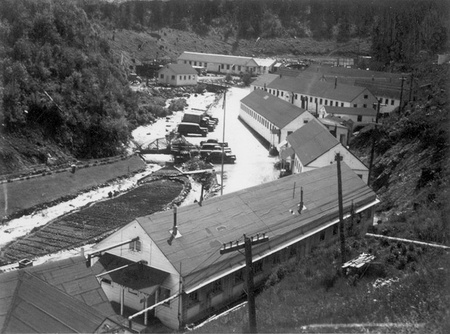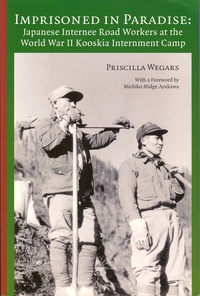Imprisoned in Paradise is a magnificent microstudy of the World War II Japanese internment experience. This is due to the creative vision of its author, the historian Priscilla Wegars. In addition to writing the present book—a decade-long process—Wegars curates the University of Idaho’s Asian American Comparative Collection and edits the collections’s research reports series, in which Imprisoned in Paradise is the third volume.
The paradoxical title prefigures the work’s central interpretive message that the heretofore largely overlooked Department of Justice-operated facility of Kooskia in north-central Idaho, although unquestionably a wartime confinement site for some 265 enemy alien men of Japanese descent between 1943 and 1945, nonetheless had qualities that rendered it relatively blissful compared to other wartime camps. It had a scenic location and a small population, but perhaps most important, because Kooskia was administered by the Department of Justice, it was governed in strict accordance with the Geneva Convention, unlike the 10 concentration camps administered by the War Relocation Authority, where 120,000 people of Japanese ancestry (two-thirds of whom were U.S. citizens) were imprisoned during the war. All of those interned at Kooskia had volunteered to be transferred there from other internment camps specifically to do roadwork.
The book begins with a foreword by the Japanese Canadian historian Michiko Midge Ayukawa, who establishes a basis for comparing the many road construction internment camps for Japanese Canadians with Kooskia. Next comes Wegars’s preface, discussing the Kooskia camp’s spectacularly beautiful surroundings, its previous use as a Civilian Concentration Corps camp and a prison camp, its cosmopolitan internee population (who came not only from the United States but also from Mexico, Panama, and Peru), and the “internees’ awareness and exploitation of the rights and privileges guaranteed them by the Geneva Convention” (p. xxiv). The author also discusses the experiences that influenced her authorship of Imprisoned in Paradise, including living in a cooperative dormitory with Japanese American women survivors of the War Relocation Authority camps when she was a student at the University of California, Berkeley.
All but 1 of the book’s 10 chapters are headed with an excerpt from a Geneva Convention article consonant with that chapter’s topic. This device accentuates the study’s theme of international law’s protective role at internment camps. The chapters discuss the establishment and provisioning of the camp, living conditions, the work the internees did, as well as what they did in their leisure time, protests at the camp, internee and employee perspectives, external scrutiny of the camp, and relations between internees and the neighbors. These chapters are so packed with information that the volume is as valuable as a reference book as it is as a monograph. Moreover, the data are consistently buttressed by documents, oral histories, and illustrations. The author has also included a useful appendix, which lists the camp’s interned men: their names and aliases, internee numbers, birthdates, prewar residences, and occupations.
Two shortcomings come to mind. First, the author could have profitably devoted a paragraph in her preface to previewing the content of the book’s chapters. Second, she might also have made provision in her study for a review of the extant literature on the subject of WWII Japanese internment camps in general. Though she has showcased attention to the quite idiosyncratic Kooskia Internment Camp, scholars have also been neglectful of the other, allegedly more normative Japanese internment camps. This neglect has been anything but salutary. What, in fact, makes Priscilla Wegars’s Imprisoned in Paradise so important and timely is not that she has filled a small topical gap; rather, it is that in the process of so doing she has provided other scholars with a heuristic model that will regenerate a greatly understudied area of inquiry.

Kooskia Internment Camp, about 1944. Foreground, administrative buildings. Background, right, barracks; center, canteen and recreation building. Note garden island in Canyon Creek, left foreground. (Courtesy Scrapbook, PG 103-02-2, Special Collections & Archives of the University of Idaho Library)
(Imprisoned in Paradise: Japanese Internee Road Workers at the World War II Kooskia Internment Camp By Priscilla Wegars. Moscow: Asian American Comparative Collection, University of Idaho, Asian American Comparative Collection Research Report, No. 3, 2010. xxxiv, 323 pp. Illustrations, map, appendix, list of abbreviations, notes, bibliography, index. $19.95)
To know more detail info about Kooskia camp >>
* This article was originally published in the Spring 2011 (Vol. 102, No. 2) issue of the Pacific Northwest Quarterly.
@ 2012 Arthur A. Hansen






